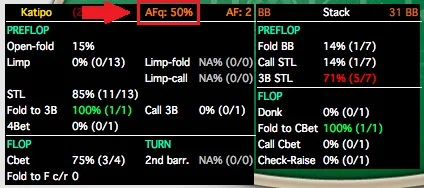What is AFQ in Poker
AFQ, or Aggression Frequency Quotient, is a statistic used in poker to quantify a player’s level of aggression. It is calculated using the formula: [(bets+raises)/(bets+raises+calls+folds)]×100. This formula gives a percentage that reflects how often a player takes aggressive actions – bets or raises – versus passive actions such as calls or folds.
Understanding a player’s AFQ offers several advantages, especially for evaluating his tactical approach and categorising his playing style. A higher AFQ indicates that a player tends to play aggressively, frequently betting and raising rather than calling. This information can be crucial for opponents trying to develop a counter-strategy, as it helps predict the aggressor’s actions and adjust their play accordingly. Understanding whether a player is aggressive, passive, or something in between helps to make better informed decisions at the table, potentially leading to better results in hands played against them.

However, the AFQ has its limitations and should not be seen as a comprehensive assessment of a player’s skill or style. One significant drawback is that it does not take into account various critical factors that affect the dynamics of the game. For example, it does not account for player hyperaggression, which can lead to higher AFQ scores without necessarily correlating with strategic or profitable play. Similarly, a player’s experience and strategic depth are not reflected in this metric. Some players may choose not to call due to their playing philosophy or strategy, which may artificially inflate their AFQ without providing insight into the overall effectiveness or nuances of their play.
It should be noted that while the Aggression Frequency Quotient is a valuable tool for understanding a poker player’s overall aggression tendencies, it has its limitations. It provides insight into how a player interacts with the mechanics of betting and raises, but is unable to capture the full range of strategic considerations such as player experience and the intricacies of game strategy. Like any statistical indicator in poker, AFQ should be used in conjunction with other observations and metrics to gain a full understanding of an opponent’s style and skill level.
You can also listen to the audio version of the page
Example of Calculating AFQ in Poker
We now examine the Aggression Frequency Quotient (AFQ) in poker through the lens of two different postflop situations in an effort to clarify the strategic tendencies of different types of players. The AFQ is calculated using the formula: AFQ= (bets+raises) / (bets+raises+calls+folds) ×100%.
This metric serves as a quantitative indicator of a player’s aggressiveness and allows you to understand his tactical approach.
Situation 1: Aggressive Player
Consider a scenario in which a player exhibits the following actions over the course of several rounds of postflop play: 10 bets, 5 raises, 3 calls and 2 folds. Substituting these values into the AFQ formula, we get:
AFQ= (10+5) / (10+5+3+2) × 100%= 15 / 20 × 100%=75%
An AFQ of 75% indicates a highly aggressive player who prefers to bet and raise rather than call or fold. Such a player is likely to be pursuing a strategy aimed at controlling the tempo of the game, putting pressure on his opponents, and forcing weak hands out of play. However, while such aggression may be effective in dictating the course of the game, it may also indicate predictability or over-reliance on aggression, which could potentially be exploited by observant opponents.
Situation 2: The Cautious Player
In a contrasting scenario, another player’s actions post-flop over several rounds are as follows: 2 bets, 3 raises, 8 calls, and 7 folds. Applying these figures to the AFQ formula, we find:
AFQ= (2+3) / (2+3+8+7) × 100%= 5 / 20 × 100% = 25%.
With an AFQ of 25%, this player demonstrates a cautious, more passive approach characterised by a preference for call and fold over aggressive betting and raising. This strategy may reflect a player who takes a more defensive stance, perhaps expecting strong hands or seeking to minimise losses. While such caution can be beneficial in avoiding unnecessary risks, it can also lead to missed opportunities to capitalise on weaker opponents or to accumulate chips through aggressive play.
Analysis and Conclusions
These contrasting scenarios highlight the usefulness of AFQ as a tool for analysing poker strategies. An aggressive player with an AFQ of 75% is likely to seek to dominate the game through force, a strategy that can be effective against passive opponents but risky against those who are able to counter aggression with strategic play. On the other hand, a cautious player with an AFQ of 25% can preserve his chip stack by avoiding risky confrontations, but may miss opportunities to exploit advantageous situations.
Thus, AFQ provides valuable information about a player’s tendencies, helping to develop a counter-strategy. However, it is important to recognise the limitations of this metric. AFQ does not take into account the context of each decision, such as hand strength, table dynamics, or the specific stage of the tournament. Thus, while AFQ can guide strategic adjustments, a comprehensive understanding of poker strategy also requires consideration of these broader situational factors.
The Aggression Frequency Quotient is an important analytical tool for understanding poker strategies, providing a numerical representation of a player’s tactical propensity for aggression. By examining different AFQ scenarios, we can infer different strategic approaches, each with their own strengths and vulnerabilities. This analysis highlights the complexity of poker strategy and the importance of adaptability and informed decision making to achieve success at the poker table.

